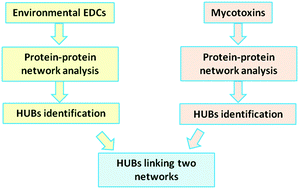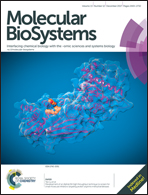An interaction network approach to study the correlation between endocrine disrupting chemicals and breast cancer†
Abstract
Endocrine disrupting chemicals (EDCs) are natural or synthetic exogenous substances affecting human health. Although present at low concentrations in the environment, they can cause a broad range of negative effects on the endocrine functions by mimicking the action of steroid hormones due to their structural similarity. Hormonal unbalance can play an important role in carcinogenesis at any stage of disease. In the case of the breast cancer, EDCs directly affect the transformation of normal breast cells into cancer cells by interfering with hormonal regulation and by inducing the alteration of factors that regulate gene expression. The principal aims of this work were to study the interaction networks of proteins modulated in breast cancer by either environmental EDCs or mycotoxins, and to identify the proteins with the strongest coordination role defined as hub nodes. Our studies evidenced the presence of seven and six hub proteins in two EDCs and mycotoxins networks, respectively. Then, by merging the two networks, we identified that three hub nodes (BCL2, ESR2 and CTNNB1) in the environmental EDCs network show direct interactions with three hub nodes (CASP8, RELA and MKI67) in the mycotoxins network. These data highlighted that two networks are linked through proteins involved in the apoptosis regulation and in processes related to cell proliferation and survival, and, thus, in breast cancer progression.



 Please wait while we load your content...
Please wait while we load your content...